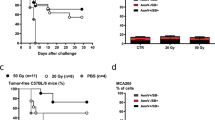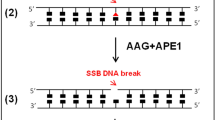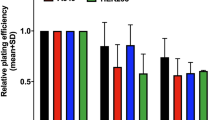Abstract
We investigated the effects of metabolic labeling with [3H]thymidine, [3H]uridine, and [14C]thymidine on human cells in terms of cell growth, p53 signaling, and nucleotide excision repair. Labeling with [3H] nucleosides resulted in growth inhibition by both p53-dependent and -independent mechanisms. Tritium labeling also led to nuclear accumulation of p53 and induction of the p53-regulated gene p21WAF1 and its encoded protein (p21). ATM-deficient cells, however, did not increase their p53 and p21 protein levels in response to radiolabeling. Thus, labeling of human cells with tritiated nucleosides activates the radiation-responsive, ATM-dependent, DNA-damage surveillance network. Labeling of normal cells with [3H]thymidine significantly accelerated the repair of ultraviolet (UV) light-induced cyclobutane pyrimidine dimers, as monitored by a sensitive immunofluorescence assay. Unlike [3H] labeling, [14C] labeling did not produce any impact on proliferation, p53 signaling, or DNA repair. In the light of these findings, the validity of results obtained with nucleic acid synthesis and DNA repair assays that involve [3H] and [14C] labeling is discussed. Our immunofluorescence approach detected pyrimidine dimers after exposure to UV fluences as low as 1 J/m2 (the lowest fluence examined). This approach may prove particularly useful for monitoring DNA damage and its repair following exposure to extremely low levels of genotoxic agents.
This is a preview of subscription content, access via your institution
Access options
Subscribe to this journal
Receive 50 print issues and online access
$259.00 per year
only $5.18 per issue
Buy this article
- Purchase on Springer Link
- Instant access to full article PDF
Prices may be subject to local taxes which are calculated during checkout





Similar content being viewed by others
References
Aboussekhra A, Biggerstaff M, Shivji MKK, Vilpo JA, Moncollin V, Podust VN, Pretic M, Hübscher U, Egly J-M and Wood RD . (1995). Cell, 80, 859–868.
Barley RDC, Enns L, Paterson MC and Mirzayans R . (1998). Oncogene, 17, 533–543.
Bickar D and Reid PD . (1992). Anal. Biochem., 203, 109–115.
Bond JA, Webley K, Wyllie FS, Jones CJ, Craig A, Hupp T and Wynford-Thomas D . (1999). Oncogene, 18, 3788–3792.
Bowman KK, Sicard DM, Ford JM and Hanawalt PC . (2000). Mol. Carcinogen., 29, 17–24.
Bunz F, Dutriaux A, Lengauer C, Waldman T, Zhou S, Brown JP, Sedivy JM, Kinzler KW and Vogelstein B . (1998). Science, 80, 1497–1501.
Chang BD, Watanabe K, Broude EV, Fang J, Poole JC, Kalinichenko TV and Roninson IB . (2000). Proc. Natl. Acad. Sci. USA, 97, 4291–4296.
Dover R, Jayaram Y, Patel K and Chinery R . (1994). J. Cell Sci., 107, 1181–1184.
Enns L, Barley RDC, Paterson MC and Mirzayans R . (1998). Radiat. Res., 150, 11–16.
Enns L, Murray D and Mirzayans R . (1999). Br. J. Cancer, 81, 959–965.
Enns L, Murray D and Mirzayans R . (2000). Photochem. Photobiol., 72, 562–568.
Ford JM and Hanawalt PC . (1997). J. Biol. Chem., 272, 28073–28080.
Gaitonde SV, Qi W, Falsey RR, Sidell N and Martinez JD . (2001). Cell Growth Differ., 12, 19–27.
Galloway AM, Liuzzi M and Paterson MC . (1994). J. Biol. Chem., 269, 974–980.
Giaccia AJ and Kastan MB . (1998). Genes Dev., 12, 2973–2983.
Hu VW and Heikka DS . (2000). FASEB J., 14, 448–454.
Hu VW, Heikka DS, Dieffenbach PB and Ha L . (2001). FASEB J., 15, 1562–1568.
Hwang BJ, Ford JM, Hanawalt PC and Chu G . (1999). Proc. Natl. Acad. Sci. USA, 96, 424–428.
Mirzayans R, Andrais B and Paterson MC . (1992). Int. J. Radial. Biol., 62, 417–425.
Mirzayans R, Bashir S, Murray D and Paterson MC . (1999). Carcinogenesis, 20, 941–946.
Mirzayans R, Enns L, Dietrich K, Barley RDC and Paterson MC . (1996). Carcinogenesis, 17, 691–698.
Mirzayans R, Famulski SF, Enns L, Fraser M and Paterson MC . (1995). Oncogene, 11, 1597–1605.
Rotman G and Shiloh Y . (1999). Oncogene, 18, 6135–6144.
Smith ML, Chen I-T, Zhan Q, O’Connor PM and Fornace Jr AJ . (1995). Oncogene, 10, 1053–1059.
Smith ML, Ford JM, Hollander MC, Bortnick RA, Amundson SA, Seo YR, Deng CX, Hanawalt PC and Fornace Jr AJ . (2000). Mol. Cell. Biol., 20, 3705–3714.
Suzuki A, Ito T, Kawano H, Hayashida M, Hayasaki Y, Tsutomi Y, Akahane K, Nakano T, Miura M and Shiraki K . (2000). Oncogene, 19, 1346–1353.
Wakasugi M, Kawashima A, Morioka H, Linn S, Sancar A, Mori T, Nikaido O and Matsunaga T . (2002). J. Biol. Chem., 277, 1637–1640.
Wang XW, Yeh H, Schaeffer L, Roy R, Moncollin V, Egly J-M, Wang Z, Friedberg EC, Evans MK, Taffe BG, Bohr VA, Weeda G, Hoeijmakers JHJ, Forrester K and Harris CC . (1995). Nat. Genet., 10, 188–195.
Yeargin J and Haas M . (1995). Curr. Biol., 5, 423–431.
Acknowledgements
We thank Bonnie Andrais and Louise Enns for technical assistance. This work was supported by the Canadian Institutes for Health Research and the Canadian Breast Cancer Foundation (Alberta Chapter).
Author information
Authors and Affiliations
Corresponding authors
Rights and permissions
About this article
Cite this article
Mirzayans, R., Pollock, S., Scott, A. et al. Metabolic labeling of human cells with tritiated nucleosides results in activation of the ATM-dependent p53 signaling pathway and acceleration of DNA repair. Oncogene 22, 5562–5571 (2003). https://doi.org/10.1038/sj.onc.1206514
Received:
Revised:
Accepted:
Published:
Issue Date:
DOI: https://doi.org/10.1038/sj.onc.1206514
Keywords
This article is cited by
-
Use of radionuclides in cancer research and treatment
Clinical and Translational Oncology (2009)
-
Loss of one p53 allele results in four-fold reduction of p53 mRNA and protein: a basis for p53 haplo-insufficiency
Oncogene (2006)



